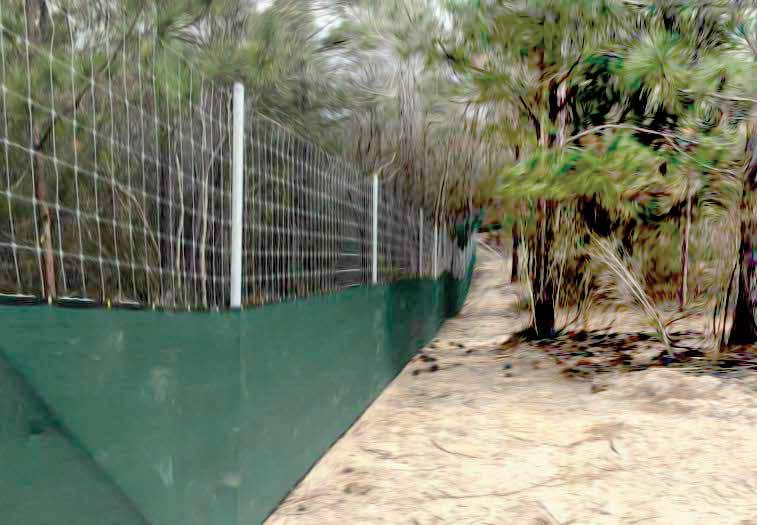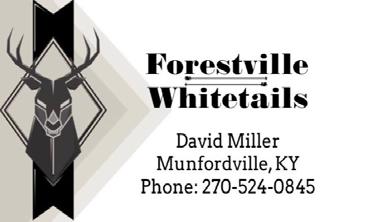
























Jason Becker
PRESIDENT
Campbellsville, KY jasonbecker757@gmail.com 757-692-5820


Jake Anderson
VICE PRESIDENT 925 Guston Rd Guston KY 40142
janderson@theluskgroup.com 270-547-8432



Ethan Woosley
9064 Shrewsbury Road Leitchfield, KY 42754 Singlecreekwhitetails@gmail.com 270-316-9698
Daniel Stallard
Copper Creek Whitetails 500 Copper Creek Rd Dawson Springs, KY 42408 214-897-1958
Patrick Stanley
Twisted Tines Ranch / Crooked Creek Whitetails P.O. Box 130 Williamstown, KY 41097
Tony Maddox
CHAIRMAN
725 Rabbit Town Rd
Winchester KY 40391
solidrockwhitetails@yahoo.com 859-556-7253 • 239-340-1171
SECRETARY
Princeton KY 42445
prestonthomasfarms@gmail.com 270-889-1001

WES BREWER
TREASURER
Hodgenville KY 42748
mwb5304@yahoo.com 502-297-1309


Henry Woodard 9776 Roseville Rd Glasgow KY 42141
woodardpropertiestn@gmail.com 423-595-8898
Josh Moore
J&L Whitetails Maysville, KY 606-748-7563
Joe Miller
4195 Penchem Rd Guthrie KY 42234
jmgreenlandsod@safecom.link 270-483-2140
David Miller
1873 Forestville Rd Mumfordville KY 42765 270-537-5357


KALA is the voice for cervid farmers in the state of Kentucky and it was a major step in the right direction having a booth at the State Fair. With this year being the 120th anniversary of the Fair, there was no better time to start than now. As David Beck, the President & CEO of KY Venues said, “The KY State Fair is special each year, but this year had an extra special energy about it.” The Fair had record breaking participation and attendance everyday. There was a plethora of visitors from every county in the state this year and even out-of-state attendees.
Throughout the 11-day event, which ran August 15th-25th, KALA talked to an unbelievable number of people who were uninformed of deer farming being an actual business. Clint Steele from ACE Whitetails, who volunteered several days at the booth said, “the organization educated more people about the deer and elk farming industry than ever before.” With known attendance of over 750,000 people into the State Fair each year, “there’s no other event in the state to have that amount of exposure,” as Henry Woodard, who also volunteered several days, commented. KALA was able to answer many questions and debunk various assumptions and in general, the public left our booth with a positive impression about deer farming.
As the state’s organization, it is KALA’s mission to promote an agricultural pursuit with quality standards and educational programs, and the State Fair provided the perfect opportunity to do just that. KALA’s booth consisted of a slideshow of member’s farm and animal photos, a giveaway for three $100 Cabela’s gift cards, and an amazing spread of information. Everything from the KALA quarterly magazines, a general information flyer, a brochure on steps to becoming a deer farmer, and a map of all the KALA members’ farms and preserves. “It’s no surprise people were very enthusiastic to learn about deer farming” Ethan Woosley commented about the booth. Several deer mounts were the talk of the booth and the recent deer auction’s selling price page in the information packet was a large eye-catcher to the public.
Setting up at the State Fair was one of the most profitable endeavors KALA has done for the organization and individual deer farmers. Jason Becker, KALA President, agreed saying, “KALA is always a mindful steward of the raised money through dues and the Showcase Fundraiser, and the State Fair was the best return on investment out there.” We had astounding feedback from the general public, with numerous people signing up to receive a deer
farming information packet, only proving to us more that having a booth was needed. “Being at the Fair was highly beneficial to talk deer with outdoorsmen, meet various politicians, and intrigue the youth about alternative livestock,” says board member, Tony Maddox with Solid Rock Whitetails.
To all the KALA members who volunteered at the booth, we want to personally thank you. Your efforts were noticed and appreciated greatly! We also want to take this opportunity to thank those who helped behind the scenes to make it possible to set up at the State Fair. It was a time crunch to even have a booth with several other events occurring in the same month, but we are so thankful to have had members to put it all together. The dedication of our members to represent KALA at the Fair was invaluable and made our industry look appealing!
Overall, the booth was a remarkable success; it was well worth the investment and all the hard work! Our purpose for having a booth was not to sell anything, but rather to enlighten the public about deer farming and promote KALA as the state’s organization for the deer and elk farming industry, especially since the need to reach out and educate publicly about deer farming is evident. We can happily say KALA succeeded and it will definitely benefit our organization. The Fair is a grand tradition of celebrating Kentucky and it’s the ideal opportunity to grow the cervid farming industry. KALA looks forward to continuing to help build the legacy of Kentucky’s State Fair.

Event Photos can be found on pages 20, 23, & 26












By: Grayson Steele
KALA wanted to reach back out to deer farmers in which a farm feature had been written to see what they’ve learned, how they are running their operation, and their future goals. To start, we talked to Dustin Blosser, the ranch manager at Woodard Whitetails of Kentucky in Glasgow, which is about 45 minutes outside of Bowling Green.
Dustin was introduced to deer farming in 2012 when his family switched from traditional livestock and started a deer farm in West Virginia, which is now much bigger and includes a small elk herd. His family farm led him to getting an internship in Texas, only sparking more interest, to work at another deer farm in Pennsylvania, 2000+ miles away from home. He has since moved back closer to home and is “extremely happy” with where he is now. With a goal
of operating his own farm and preserve one day, he says, “there’s no better situation than the one I’m in right now. I feel like I’m on track to achieve my goal.”
Being the ranch manager, Dustin manages over 400 cervids (elk and whitetail combined). He is in the pens several times a day making sure the animals are healthy, fed, and have plenty of water. For whitetail deer, Woodard Whitetails runs one deer per 1500 square feet and around 15 head per pen. It’s ideal to have a few empty pens to rotate the deer around on fresh ground too. Just recently Woodard Whitetails got a herd of elk, so they are still figuring out a healthy, desirable amount of acreage needed for the elk. However, it is dependent upon the soil and climate. Dustin says due to the animal’s calm demeanor and
less health issues, elk are easier to care for, even though they require heavier equipment and more space.
Woodard Whitetails’ breeding operation is still evolving just like any other deer farm. They currently have a variety of deer, which is working for their hunting preserve; however, the goal is to raise more consistent, CWD resistant typicals. Dustin believes farmers need to strive for CWD resistance breeding to protect the industry. Knowing the pedigrees of deer’s bloodlines is important for breeding, especially to predict the future genetic production. Dustin says, “personally, I believe a pedigree is just a piece of paper if that animal doesn’t produce. I would rather have a no-name doe that gives me great bucks than I would to have a doe with a great pedigree that gives me sub-par


bucks.” Another part of Woodard Whitetails’ breeding operation includes artificial insemination. They typically AI around 150180 deer every year in order to make genetic improvements such as CWD scores or tine length. AI allows them to introduce outcrosses and stack desirable genetics into their closed herd. Bottle feeding is different for every farm, but at Woodard Whitetails only the fawns that need it get bottle fed each year, which includes the runts, triplets, and sick. Although, they do bottle feed their doe fawns every few years to have tame animals. During the summer, the fawns are checked three or more times a day, making them tame without even having to bottle feed. Frequent checks and calm demeanors make health checks and darting much easier as well as when handling and running the animals through alleyways and barns. Dustin says the most important things for raising healthy fawns include giving the
top three vaccinations (against things your farm battles), keeping detailed notes (illness, treatments, parents, pen location, birthdate), and the sanitation of fawn barn and pens. The bottle feeding facility at Woodard Whitetails is plastic and concrete making it easy to keep clean, especially since they started using pen cleanse to sanitize their pens. Dustin says, “vaccinating and limiting exposure to pathogens helps stop the problem before it starts.”
Reflecting on his deer venture, Dustin wishes he had researched more at the beginning. He says his family just jumped into it and was not the most knowledgeable on vaccines, medications, pedigrees, or illnesses. Therefore, he recommends anyone who is thinking about starting a deer farm to do their research.
Extremely passionate about deer farming, Dustin is vitally active with KALA. He says he got more involved to help make deer farming better
as an organization at the state level. “Making a more positive perception of the industry to the general public would make changing regulations easier and maybe encourage more people to start deer farming.” Dustin made the comment that the amount of unnecessary regulations places burdens on producers and the industry as a whole. Dustin encourages everyone to reach out to each other. He says, “deer farming is a small community and we need each other to keep it alive and healthy.” KALA is thankful to have Dustin involved in Kentucky’s deer farming industry and appreciates all he does within our state’s organization.








I hereby make application for membership the
I agree to confirm to the bylaws and code of ethics governing the association. Signature Date:





With an increasingly divisive election campaign, Congressional deadlock, and a looming government funding deadline on October 1st, it is clear that 2024 will be a pivotal year for American politics. Congress has so far failed to pass its twelve annual appropriations bills for fiscal year 2025 (FY25), including the Farm bill by the August recess, and debates on immigration and foreign aid are expected to play out as election season begins.
On November 5th, Vice President Kamala Harris (D) will face former President Donald Trump (R) to decide who will be the 47th President of the United States. At the moment, polling shows the candidates to be statistically tied nationally while Vice President Harris holds a slim lead in most swing states. On July 15th, former President Trump announced his selection for freshman Ohio Senator J.D. Vance while Vice President Harris selected Minnesota Governor Tim Walz. Both VP picks appear intended to bolster their running mate’s standing in Midwest battleground states such as Ohio and Michigan. Down-ballot Republicans are broadly expected to gain a majority in the Senate, where the Democrats will be forced to defend eights seats located in swing states and red states. The House of Representatives appears to be in play for either party.
On March 23rd President Biden signed a continuing resolution (CR) for the funding of the federal government through September 30th. The bill passed the House of Representatives with a margin of 286-134 and the Senate by a margin of 74-24. Major provisions included additional funding for the National Institutes of Health, measures to respond to the opioid epidemic and the Low Income Energy Assistance Program. As the October 1st deadline for the FY25 appropriations bills draws closer, the current process is ongoing but it is not expected that a majority of the spending bills will pass before election day.
On June 11th, the House Appropriations Committee released the initial version of the FY2025 Farm bill. The bill would provide additional funding to safety-net programs for farmers as well as doubling the allocation to support trade promotion efforts. Speciality crop programs also saw funding increases, improved the availability of energy cost reduction programs and implements new measures to track land purchase by foreign entities, particularly those based in China. More controversially, the bill includes two items that have proved extremely unpopular with Democrats, leaving the current bill unlikely to pass the Senate. These provisions are limits placed on future increases in funding for the Supplemental Nutrition Assistance Program (SNAP) and the removal of ‘climate-smart’ requirements for the use of $13 billion in conservation funding allocated in the Inflation Reduction Act (IRA) earlier this year. These issues will need to be resolved if the bill is to pass before the September 30th deadline although it is possible that both the Farm bill and National Defence Authorization Act (NDAA) would remain funded until the end of the year, even without an agreement.
It remains unclear how the Farm Bill under consideration will look, after amendments and negotiations between the House and Senate. However, both parties have expressed the desire to pass all major legislation for FY25 before the October 1st deadline. If they fail to meet this target it is likely that funding will be allocated in the form of continuing resolutions (CR) to maintain levels of funding from the last fiscal year until a compromise can be reached or a new government installed. As the election is getting closer, lawmakers are using August and October to campaign for their respective seats and garner support for their preferred presidential candidate. Although it is unclear who the winner will be in the White House and which party will have control of Congress, the country is set for another historic election once again.


IF YOU HAVEN’T TRIED PNEU-DART’S RDD S, YOU’RE MISSING MORE THAN YOUR TARGET































By: Gail Veley • Sponsored by The Minnesota Deer Farmers Association
Finding creative and lucrative ways (within the scope of the deer industry) to subsidize your deer farm may prove beneficial and ultimately cost-effective, offers Mark Volk of Volk Whitetails in Royalton, Minnesota. When Mark and his wife Mary started their 8-acre farm in 2014, fate would later point them in a direction they never saw coming. Today, in addition to raising deer, they also own and operate CuddliEZ, a custom embroidery company that manufactures deer masks with farm logos that keeps Mary extremely (if almost) too busy. This demonstrates there are various ways to turn an additional profit from deer farming, other than just the raising and selling of deer, Volk, 40, explained.
Some of these ways include:
Deer Velvet: Widely used in oriental medicine, deer velvet, when taken as a supplement, is thought to increase joint mobility, overall flexibility, strength, energy and blood flow. Found growing on the outside of buck antlers in the summer, deer velvet contains important chemicals, amino acids and collagen. Antlers
in velvet that are properly trimmed and stored from whitetails, red deer and elk can be sold to interested manufacturers, such as Cervid Labs USA, who purchase elk antlers. Other companies who purchase antlers in velvet can be found with online research.
Deer Capes: A deer cape, essentially the hair and hide from the nose to shoulder of a deer, if properly skinned, can be sold to the taxidermy market to enhance wall mounts. They can also be prepared and used as stand-alone decorative displays.
Urine Collection: Doe and buck urine, used to cover up the scent of hunters while attracting deer to a hunting location, is a popular go-to for hunters. Several deer farmers have taken to the business of collecting, processing and selling deer urine as the demand is very high. Through the construction of special collection stalls, substantial amounts of urine can be collected in a short amount of time, adding to the appeal of starting or contributing to a urine collection and distribution business.

Antler Collection / Selling: Hard deer antlers are used to make a variety of useful items such as tools, jewelry, chew bones for dogs and much more. Single antlers and antler sheds are bought from deer farmers from a wide variety of U.S. companies and are usually priced from $8 to $15 per pound.
Antler Replication / Taxidermy:
Although very time-consuming, antler replication and taxidermy is highly sought out as the demand from hunters for these services is very high. Those in this profession are never without work and devote long hours to perfecting their craft and keeping customers happy.
Farm Tours: A fascination with deer, particularly whitetails, is the driving force behind every deer farmer’s desire to raise deer. Likewise, the general public often shares this fascination and curiosity. For several years Mike Czora and Sandy Malone of Prime Whitetails in Rush, New York offered “Walk with Whitetails,” at a reasonable price to individuals and families interested in an up close and personal experience, after they realized how popular it could be. Turns out they were right.
“Our secondary deer business of making embroidered deer masks has helped us cover the cost of our feed,” Volk said. “It can be vital to look for other ways to financially subsidize your farm. We all know how quickly costs add up and how important having discretionary income can be.”














Just in time for semen sales, getting ready for breeding season!
We created this magazine in order for 2024 Breeder and Hunting Preserve advertisers to showcase their most recent photos of their bucks close to the last days of antler growth. We realize establishing a collective deadline for all states Fall magazines to publish on the same date to obtain last-minute photos would be impossible to achieve. With this magazine, advertisers have one more chance to showcase their bucks.
~ Thank you to all that participated!



... if you would like to participate in our 2025 magazine, give us a call for more information. 320-905-2622 or 260-222-3478




By: Gail Veley • Sponsored by The Alabama Deer Farmers Association
Successfully getting your does from the weaning pens to the breeding pens can be considered somewhat of a science, perfected through the course of experience combined with a little trial and error. “Breeding plans can get complicated with everything you need to consider such as CWD resistance, pedigrees and antlers,” explains Cameron Odom, owner of Five O’s Ranch, a 41-acre spread begun in 2015 in Citronelle, Alabama. At Five O’s Ranch, a farm which is currently home to 140 deer that is expecting close to 100 fawns in the spring, “we make every effort to make sure our does are as healthy as they can be and ready for breeding season.”
At the forefront of these preparations should be the constant monitoring for and prevention of EHD. The city of Citronelle, known since 1955 as the oil capital of Alabama and located 34 miles north of Mobile, has its fair share of annual rain and occasional hurricanes and along with that a higher prevalence of bacteria, midge flies and EHD.
“If a doe has had a bout of EHD close to breeding season, I highly recommend not putting her through the stress of A.I.,” Odom, 48, said. “At our farm, we would breed her naturally instead through live cover.”
To have the healthiest does, a diet high in quality hay, grain and minerals is recommended yearround, with an increase of those things during the winter and spring months as fawns are developing, born and raised (simultaneously along with future breeding plans and preparations.) “I feel this is something every farm should practice, along with regular wormings and vaccinations, to ensure their does have appropriate antibodies and that their body condition is good,” Odom said.
Body condition and overall health also factors into weaning fawns. “If one of your does becomes sick in August or September, it’s not recommended that you compound the situation by pulling fawns off,” Odom said. “Wait a couple weeks


or so until she is healthy again. Remember you want your does as strong and as healthy as they can get as breeding season approaches.”
A strong hunting economy, perpetuated by an abundance of state-wide preserves, means the demand for deer is high. In Alabama, a closed-border state, maintaining healthy deer herds is essential to the long-term success of every deer farm. “Essentially, good animal husbandry is the biggest key to success,” Odom shared. “Knowing your herd and laying eyes of them every day, even twice a day, is an important part of this. Be vigilant and aware. Vaccinate and utilize A.I. whenever you can to increase hearty genetic variety while being mindful of your end market. Is CWD resistance important? Antler size? Negative GEBV markers? Or all of the above?”
Odom feels everyone involved in The Alabama Deer Farmers Association strives hard to stay abreast of the latest industry trends, and to be compliant with the regulations set in place by The Alabama Department of Conservation and Natural Resources. “We have a great group of deer farmers operating well-run and well managed deer farms,” Odom said. “We are grateful for the opportunity to do what we love with the support of our spouses, friends, family and customers.”






Disclaimer: The information contained in this advertisement is general in nature and is intended for use as an informational aid. It does not cover all possible uses, actions, precautions, side effects, or interactions of the medications shown, nor is the information intended as medical advice or for making an evaluation as to the risks and benefits of using a particular medication. You should consult with your veterinarian about diagnosis and treatment of any health problems. Information and statements have not been evaluated by the Food and Drug Administration (FDA), nor has the FDA approved the medications to diagnose, cure or prevent disease. Medications compounded by Mixlab are prepared at the direction of a veterinarian. Mixlab compounded veterinary preparations are not intended for use in food and food-producing animals. Mixlab does not recommend, endorse or make any representation about the efficacy, appropriateness or suitability of any specific dosing, products, procedures, treatments, services, opinions, veterinary care providers, or other information that may be contained in this advertisement. Mixlab is not responsible nor liable for any advice, course of treatment, diagnosis or any other information, services or products that you obtain through this advertisement.

Phone (260) 248-1684

#1300/392156


By: Gail Veley • Sponsored by MDA
With shovels in hand and an agenda to fill, Rachel and Brad Monnig recently trenched 600 feet of water line at their eight-acre farm, Cedar Ridge Whitetails in Salisbury, Missouri. After fifteen years of dragging hoses to water troughs it was time for something easier. In fact, it was way past time. Today water hydrants line their deer farm, saving them a substantial amount of time caring for their deer.
Saving time and money when raising deer is a subject Roxanne and Jeff Knibb of Knibb Whitetails near St. Louis, Missouri, know all too well. Today, their seven breeding pens are lined with Rangemaster high-tensile horse fence. Fawns no longer get their heads stuck in the fence. Strips of Geogrid no longer litter the pens, making for a much better presentation during farm tours. And life is good for their deer herd, which numbers close to 200 head, housed in 19 one-acre pens. However, things did not start out so well when they acquired their first deer, four bred does, in 2009.
“We thought we could preempt the problem of fawns escaping through six-inch spacing without having to line the breeding pens,” Roxanne, 62,

explained. “So, we used Stay-Tuff fence with three-inch spacing on the whole farm. The problem was, while the fawns could not escape, they still tried . . . and got their heads stuck in the fence.” Their first ‘solution’ was to line the breeding pens with Geogrid, a lightweight plastic product that was easily attached to the Stay-Tuff fence using cable ties. But both the Geogrid and the cable ties degraded with exposure and had to be replaced every few years. The deer also took to entertaining themselves by tearing strips off the fence and distributing them around the pen.
The solution that finally and actually worked very well was in lining the breeder pens with Rangemaster horse fence from Kencove (Fastlock Woven Wire, 13/48”/2”, 12 ½ Ga). The Knibbs used a Pneumatic Hog Ring Tool (Type HC715) and stainless-steel Hog Rings (KSF15SS100B, C-ring style, .75” open/.3125” closed), both from King-Hughes Fasteners, to attach the Rangemaster fence to the Stay-Tuff fence as needed (about one ring per square foot of fence). “At first we were afraid the fence would be so stiff that more fawns would die when they hit it,” Roxanne said. “But the fence has been


up since 2021, and thankfully, that has not been the case. A fence that provides safety and longevity is a joy to have.”
Looking at longevity factors such as fencing is something the Monnig’s wholeheartedly agree with, along with the selection of genetics, pen design and layout at their farm which now houses close to 70 deer. “Looking back, we should have toured a lot more farms and asked a lot more questions,” Rachel, 35, said. “You’re always going to end up with more deer than you planned. Determining your future ‘add-ons’ and how that would go with your existing layout is important. It’s also important to know your goals and who you’re trying to sell to, the breeder market or stocker market. As a farm that raises stockers, we now use sexed semen so we will have more bucks than does.”
If the Monnig’s and Knibb’s could offer a universal piece of advice to new deer farmers – it’s longevity. “The key is all in the planning,” Rachel said. “For example, consider power does. They are hard to make and hard to replace. Or that doe that will milk any baby. Always plan for what the future could mean with every decision you make. It will pay off.”


Fawn CradlesFor pricing and ordering contact Ace Whitetails at acewhitetailsky@ gmail.com or text (502) 994-8656

2024 Doe Fawns For sale! Certified KY herd, can go to any state that can import from KY! Everything on the farm has TSU samples pulled, just needs to be sent in for parentage! We usually have a few available every year due to lack of space.
Single Creek Whitetails 270-230-7978
If you would like to place an ad in the KALA Classifieds, please contact Ethan Woosley, or Josh Moore to place an Ad. It is totally Free advertising for KALA members!! If you have a business card and you would like to see it in the magazine section it is also free to KALA members, please contact Ethan Woosley to get those in!




The rules for sudoku are simple:
A 9x9 square must be filled in with numbers from 1-9 with no repeated numbers in each line, horizontally or vertically.
To challenge you more, there are 3x3 squares marked out in the grid, and each of these squares can’t have any repeat numbers either.





















If you are a Kentucky Hunting Preserve and would like to share one of your game recipes to KALA’s Kitchen and be featured in one of our upcoming KALA Magazine issues please contact Maryann Hall at solidrockwhitetails@ yahoo.com or call 859-556-7262. All you have to do is be a KALA member to participate!

By Ace Whitetails
• 1 pound ground venison
• Olive oil
• Medium onion, chopped
• Green bell pepper, chopped
• Red bell pepper, chopped
• Squash, chopped (optional)
• Zucchini, chopped (optional)
• 1 cup canned tomatoes
• 1 teaspoon Worcestershire sauce
• 1/2 teaspoon salt
• A dash of pepper
• Noodles of your choosing

1. Gently brown the venison in olive oil. Add in the onion, bell peppers, squash, and zucchini. Continue cooking until onion is lightly brown and vegetables are softened.
2. In a 4-quart cooking pot, add tomatoes, Worcestershire, salt, and pepper (add a little water if you want it more soup-like). Stir and heat to a boil.
3. Cook your noodles.
4. Mix the meat and vegetables in with the ingredients in the pot with the sauces. Then add your noodles.
5. Serve with shredded cheese sprinkled on top!
Serves 2-4 people.



If you would like your farm or business featured on our business card pages, email digital pdf file or scanned image (must be readable resolution) of your business card to: : Singlecreekwhitetails@gmail.com

This gives KALA members a way to reach out to one another for services and to buy or sell deer! There will be limited pages for these card spreads, first come first serve. The overflow would be placed in the next issue and cards will be rotated each quarter.
Please Note: Business Cards will be rotated as space allows, if you don’t see your card here it should appear in the next issue. If you have any concerns please double check that your membership is up to date and feel free to contact us or resend your card.
























Does the sound of antlers clashing make you cringe each fall?



SAVE 5% ON PEACEMAKER THROUGH PBS ANIMAL HEALTH DURING SEPT- NOV 2023

























DESIGNED TO HELP INCREASE YOUR PEACE OF MIND... WHEN YOU NEED IT MOST!

Rut and reduced feed intakes can bring out the worst in bucks and irritable behavior can rear it’s ugly head!
PeaceMaker is scientifically formulated to provide optimal support levels of magnesium, Vitamin B1 and inositol to help maintain a normal and relaxed disposition in cervids
Now enhanced with appetite stimulants and probiotics for digestive health
Contains no herbals nor tryptophan, eliminating concerns of unwanted side effects
Use PeaceMaker™ to help “keep the peace” during pre-rut, rut, transportation and other key times during the year
Now available in a 30 lb resealable bag and 11.25 lb pail to help fit your operation’s needs

ROBUST, FAST GI SUPPORT FOR FAWNS & OLDER DEER

Designed to quickly support normal GI health
Novel formula delivers powerful immune support
Can be used post tranquilization to help speed recovery











30 LB. RESEALABLE BAG!

DIGESTIVE HEALTH & IMMUNE SUPPORT CERVIDS OF ALL AGES

Supports digestive health and a healthy immune system
Natural formula contains Encrypt®, egg proteins, enzymes, micro-encapsulated probiotics and a prebiotic
Top dress or mix in feed during fawning season, weather changes, times of stress and when top performance is desired






Answers to puzzles will be available in the next issue, or can be found on our website: www.deersites.com Coloring pages can be mailed to: “Samantha Uchytil, 19291 59th St NE, New London, MN 56273” or emailed to “deerassociations@gmail.com” for a chance to be featured in the next issue!









44 ISSUES FOR 1 YR. (11 Publications x 4 quarters) - 18
$180 / Issue ($7920. / Yr) ~ Full Page
$102 / Issue ($4488. / Yr.) ~ Half Page (55-59%Discountoff singleadplacement)

16 ISSUES FOR 1 YR. (4 Publications of your choice x 4 quarters)
$204 / Issue ($3264. / Yr) ~ Full Page
$112 / Issue ($1792. / Yr.) ~ Half Page (48-54%Discountoff singleadplacement)




4 ISSUES FOR 1 YR. (1 Publication x 4 quarters)
$238 / Issue ($952. / Yr) ~ Full Page
$130 / Issue ($520. / Yr.) ~ Half Page (40-48%Discountoff singleadplacement)


























